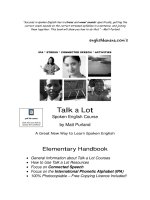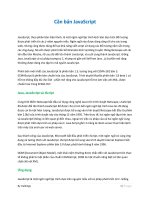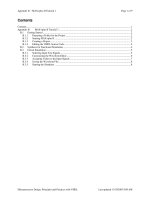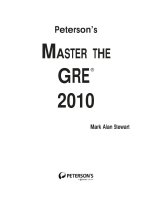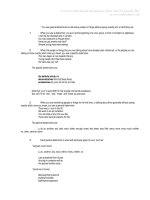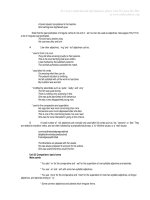Tài liệu Collins cobuild student grammar part 1 docx
Bạn đang xem bản rút gọn của tài liệu. Xem và tải ngay bản đầy đủ của tài liệu tại đây (48.77 KB, 15 trang )
For more material and information, please visit Tai Lieu Du Hoc
at www.tailieuduhoc.org
Unit 1 Clause and sentence structure
Main points
* Simple sentences have one clause.
* Clauses usually consist of a noun group as the subject, and a verb group.
* Clauses can also have another noun group as the object or complement.
* Clauses can have an adverbial, also called an adjunct.
* Changing the order of the words in a clause can change its meaning.
* Compound sentences consist of two or more main clauses. Complex sentences always include a subordinate
clause, as well as one or more main clauses.
1 A simple sentence has one clause, beginning with a noun group called the subject. The subject is the person or
thing that the sentence is about. This is followed by a verb group, which tells you what the subject is doing, or describes the subject's
situation.
I waited.
The girl screamed.
2 The verb group may be followed by another noun group, which is called the object. The object is the person or
thing affected by the action or situation.
He opened the car door.
She married a young engineer.
After link verbs like `be', `become', `feel', and `seem', the verb group may be followed by a noun group or an adjective,
called a complement. The complement tells you more about the subject.
She was a doctor.
He was angry.
3 The verb group, the object, or the complement can be followed by an adverb or a prepositional phrase, called
an adverbial. The adverbial tells you more about the action or situation, for example how, when, or where it happens. Adverbials are
also called adjuncts.
They shouted loudly.
She won the competition last week.
He was a policeman in Birmingham.
4 The word order of a clause is different when the clause is a statement, a question, or a command.
He speaks English very well. (statement)
Did she win at the Olympics? (question)
Stop her. (command)
Note that the subject is omitted in commands, so the verb comes first.
5 A compound sentence has two or more main clauses: that is, clauses which are equally important. You join
them with `and', `but', or `or'.
He met Jane at the station and went shopping.
I wanted to go but I felt too ill.
You can come now or you can meet us there later.
Note that the order of the two clauses can change the meaning of the sentence.
He went shopping and met Jane at the station.
If the subject of both clauses is the same, you usually omit the subject in the second clause.
For more material and information, please visit Tai Lieu Du Hoc
at www.tailieuduhoc.org
I wanted to go but felt too ill.
6 A complex sentence contains a subordinate clause and at least one main clause. A subordinate clause gives
information about a main clause, and is introduced by a conjunction such as `because', `if', `that', or a `wh'-word. Subordinate clauses
can come before, after, or inside the main clause.
When he stopped, no one said anything.
If you want, I'll teach you.
They were going by car because it was more comfortable.
I told him that nothing was going to happen to me.
The car that I drove was a Ford.
The man who came into the room was small.
Unit 2 The noun group
Main points
* Noun groups can be the subject, object, or complement of a verb, or the object of a preposition.
* Noun groups can be nouns on their own, but often include other words such as determiners, numbers, and
adjectives.
* Noun groups can also be pronouns.
* Singular noun groups take singular verbs, plural noun groups take plural verbs.
1 Noun groups are used to say which people or things you are talking about. They can be the subject or object of
a verb.
Strawberries are very expensive now.
Keith likes strawberries.
A noun group can also be the complement of a link verb such as `be', `become', `feel', or `seem'.
She became champion in 1964.
He seemed a nice man.
A noun group can be used after a preposition, and is often called the object of the preposition.
I saw him in town.
She was very ill for six months.
2 A noun group can be a noun on its own, but it often includes other words. A noun group can have a determiner
such as `the' or `a'. You put determiners at the beginning of the noun group.
The girls were not in the house.
He was eating an apple.
3 A noun group can include an adjective. You usually put the adjective in front of the noun.
He was using blue ink.
I like living in a big city.
Sometimes you can use another noun in front of the noun.
I like chocolate cake.
She wanted a job in the oil industry.
A noun with 's (apostrophe s) is used in front of another noun to show who or what something belongs to or is connected
with.
I held Sheila's hand very tightly.
He pressed a button on the ship's radio.
For more material and information, please visit Tai Lieu Du Hoc
at www.tailieuduhoc.org
4 A noun group can also have an adverbial, a relative clause, or a `to'-infinitive clause after it, which makes it
more precise.
I spoke to a girl in a dark grey dress.
She wrote to the man who employed me.
I was trying to think of a way to stop him.
A common adverbial used after a noun is a prepositional phrase beginning with `of'.
He tied the rope to a large block of stone.
The front door of the house was wide open.
I hated the idea of leaving him alone.
Participles and some adjectives can also be used after a noun.
See Units 19 and 29.
She pointed to the three cards lying on the table.
He is the only man available.
5 Numbers come after determiners and before adjectives.
I had to pay a thousand dollars.
Three tall men came out of the shed.
6 A noun group can also be a pronoun. You often use a pronoun when you are referring back to a person or thing
that you have already mentioned.
I've got two boys, and they both enjoy playing football.
You also use a pronoun when you do not know who the person or thing is, or do not want to be precise.
Someone is coming to mend it tomorrow.
7 A noun group can refer to one or more people or things. Many nouns have a singular form referring to one
person or thing, and a plural form referring to more than one person or thing.
See Unit 4.
My dog never bites people.
She likes dogs.
Similarly, different pronouns are used in the singular and in the plural.
I am going home now.
We want more money.
When a singular noun group is the subject, it takes a singular verb. When a plural noun group is the subject, it takes a
plural verb.
His son plays football for the school.
Her letters are always very short.
Unit 3 The verb group
Main points
* In a clause, the verb group usually comes after the subject and always has a main verb.
* The main verb has several different forms.
* Verb groups can also include one or two auxiliaries, or a modal, or a modal and one or two auxiliaries.
* The verb group changes in negative clauses and questions.
* Some verb groups are followed by an adverbial, a complement, an object, or two objects.
For more material and information, please visit Tai Lieu Du Hoc
at www.tailieuduhoc.org
1 The verb group in a clause is used to say what is happening in an action or situation. You usually put the verb
group immediately after the subject. The verb group always includes a main verb.
I waited.
They killed the elephants.
2 Regular verbs have four forms: the base form, the third person singular form of the present simple, the `-ing'
form or present participle, and the `-ed' form used for the past simple and for the past participle.
ask* asks* asking* asked
dance* dances* dancing* danced
reach* reaches* reaching* reached
try* tries* trying* tried
dip* dips* dipping* dipped
Irregular verbs may have three forms, four forms, or five forms. Note that `be' has eight forms.
cost* costs* costing
think* thinks* thinking* thought
swim* swims* swimming* swam* swum
be* am/is/are* being* was/were* been
See the Appendix for details of verb forms.
3 The main verb can have one or two auxiliaries in front of it.
I had met him in Zermatt.
The car was being repaired.
The main verb can have a modal in front of it.
You can go now.
I would like to ask you a question.
The main verb can have a modal and one or two auxiliaries in front of it.
I could have spent the whole year on it.
She would have been delighted to see you.
4 In negative clauses, you have to use a modal or auxiliary and put `not' after the first word of the verb group.
He does not speak English very well.
I was not smiling.
It could not have been wrong.
Note that you often use short forms rather than `not'.
I didn't know that.
He couldn't see it.
5 In `yes/no' questions, you have to put an auxiliary or modal first, then the subject, then the rest of the verb
group.
Did you meet George?
Couldn't you have been a bit quieter?
In `wh'-questions, you put the `wh'-word first. If the `wh'-word is the subject, you put the verb group next.
Which came first?
Who could have done it?
For more material and information, please visit Tai Lieu Du Hoc
at www.tailieuduhoc.org
If the `wh'-word is the object or an adverbial, you must use an auxiliary or modal next, then the subject, then the rest of
the verb group.
What did you do?
Where could she be going?
6 Some verb groups have an object or two objects after them.
See Units 72 and 73.
He closed the door.
She sends you her love.
Verb groups involving link verbs, such as `be', have a complement after them.
See Unit 80.
They were sailors.
She felt happy.
Some verb groups have an adverbial after them.
We walked through the park.
She put the letter on the table.
Unit 4 The imperative and `let'
Main points
* The imperative is the same as the base form of a verb.
* You form a negative imperative with `do not', `don't', or `never'.
* You use the imperative to ask or tell someone to do something, or to give advice, warnings, or instructions on
how to do something.
* You use `let' when you are offering to do something, making suggestions, or telling someone to do something.
1 The imperative is the same as the base form of a verb. You do not use a pronoun in front of it.
Come to my place.
Start when you hear the bell.
2 You form a negative imperative by putting `do not', `don't', or `never' in front of the verb.
Do not write in this book.
Don't go so fast.
Never open the front door to strangers.
3 You use the imperative when you are:
* asking or telling someone to do something
Pass the salt.
Hurry up!
* giving someone advice or a warning
Mind your head.
Take care!
* giving someone instructions on how to do something
Put this bit over here, so it fits into that hole.
Turn right off Broadway into Caxton Street.
For more material and information, please visit Tai Lieu Du Hoc
at www.tailieuduhoc.org
4 When you want to make an imperative more polite or more emphatic, you can put `do' in front of it.
Do have a chocolate biscuit.
Do stop crying.
Do be careful.
5 The imperative is also used in written instructions on how to do something, for example on notices and packets
of food, and in books.
To report faults, dial 6666.
Store in a dry place.
Fry the chopped onion and pepper in the oil.
Note that written instructions usually have to be short. This means that words such as `the' are often omitted.
Wear rubber gloves. Turn off switch. Wipe bulb.
Written imperatives are also used to give warnings.
Reduce speed now.
6 You use `let me' followed by the base form of a verb when you are offering to do something for someone.
Let me take your coat.
Let me give you a few details.
7 You use `let's' followed by the base form of a verb when you are suggesting what you and someone else
should do.
Let's go outside.
Let's look at our map.
Note that the form `let us' is only used in formal or written English.
Let us consider a very simple example.
You put `do' before `let's' when you are very keen to do something.
Do let's get a taxi.
The negative of `let's' is `let's not' or `don't let's'.
Let's not talk about that.
Don't let's actually write it in the book.
8 You use `let' followed by a noun group and the base form of a verb when you are telling someone to do
something or to allow someone else to do it.
Let me see it.
Let Philip have a look at it.
Unit 5 Questions
Main points
* In most questions the first verb comes before the subject.
* `Yes/no'-questions begin with an auxiliary or a modal.
* `Wh'-questions begin with a `wh'-word.
1 Questions which can be answered `yes' or `no' are called `yes/no'-questions.
`Are you ready?' - `Yes.'
`Have you read this magazine?' - `No.'
If the verb group has more than one word, the first word comes at the beginning of the sentence, before the subject. The
rest of the verb group comes after the subject.

